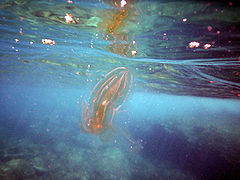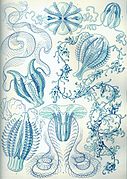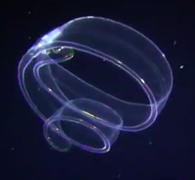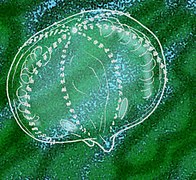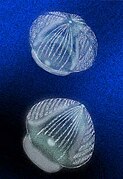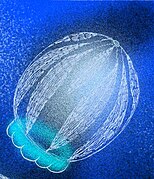Ctenophora
The ctenophores (Ctenophora, from the Greek Κτενός ctenos, «comb», and φόρος phoros, « carrier") are a phylum of diblastic animals characterized by the presence of specialized cells, the colloblasts, which produce a sticky substance used to capture prey. They are exclusively marine and 166 species have been described. Although little known, they are very abundant in seas around the world, constituting a high proportion of plankton biomass. Some have a jellyfish-like appearance, which is why they were grouped with them in the ancient phylum of coelenterates, and others look like flattened worms on the ocean floor (crawling forms). They live from the surface to 3,000 meters or more deep.
General characteristics
Many ctenophores are similar to jellyfish, but unlike jellyfish that have cnidocytes, ctenophores have colloblasts, exclusive cells of this group, used to catch food (zooplankton). They have biradial symmetry or false bilateral symmetry, presenting two axes of symmetry. A few present bilateral symmetry, but it is not unique within the radiates since some cases with this type of symmetry also appear in the Cnidaria phylum.
They contain eight linear rows of cilia, called swimming paddles or combs (hence their name) that move synchronously to swim (those that do; some live on the bottom or on other animals). Some have a pair of tentacles, others do not. They do not have excretory, respiratory or circulatory systems; they do have a digestive system and nervous and muscular systems.
They have bioluminescence that depends on the mesoglea, where the muscle cells are for contractions.
Its body, with a gelatinous appearance, is spheroidal or pyriform; some are ribbon-shaped. At the oral pole the mouth opens, shaped like a slit, and at the aboral pole (opposite end) is a characteristic sensory organ including a statocyst.
Anatomy
Symmetry
Ctenophores generally present a symmetry that can be defined as biradial symmetry or bisymmetry: two planes divide the animal into two mirror images along the oral-aboral axis. The mouth and pharynx are compressed, defining a plane of bilateral symmetry that we call the buccal or sagittal plane. The position of the tentacles defines the second plane of bilateral symmetry: tentacular or transverse plane, which is perpendicular to the previous one.
Some authors consider that in reality the ctenophores do not have radial or bilateral symmetry, but rather rotational symmetry, that is, there is no plane that divides them into mirror images, as occurs in animals with bilateral or radial symmetry; instead, any plane drawn through the central oral-aboral axis divides a ctenophore into two equal halves, but simply rotated 180 degrees.
Digestive system
Following the mouth is a pharynx that secretes enzymes and produces pre-digestion. Next, a wide and wide area appears, the stomach, which branches into 5 channels, thus increasing its surface area to capture more water with food. Of the 5 channels, two are the pharyngeal channels, which start from the stomach and return to the mouth, but before reaching it, they end up in a blind bottom. Two other canals are the transverse canals, of short length, which in turn are divided into three branches, the first is the tentacular canal (so called because it ends next to the tentacular bags) the other two branches are the interradial canals, which are They divide again in two and end in the southern channels. They have eight lateral meridional channels, which run in the oral-aboral direction, where the gonads are housed. Finally, after the stomach, the aboral canal reaches the upper part, the rectum, and ends at two anal pores that communicate the digestive system with the outside.
Nervous system
It is a subepidermal plexus (lattice) of neurons below the dermis and is distributed throughout the body. Together with the apical sensory organ, it controls the start and end of beating of the swimming paddles, as well as their rhythm, effective stroke direction, and wave speed.
Locomotor system
It is made up of eight meridian bands of swimming paddles, grouped into four pairs (each pair located in an interradius), which start from the aboral pore and run through the body to the vicinity of the oral pole. These bands contain hair cells, the cilia of which are partly fused into a comb-like pattern that beats together as a unit. These combs are the characteristic that gives the edge its name; ctenos means comb in Greek. The paddles communicate at the aboral pole with the balance organ or statocyst. Four ciliated grooves extend outside the statocyst, bifurcating to continue into the eight ciliated bands.
The coordinated beating of the ciliated bands propels the animal through the water. The bands of cilia in each row beat in sequence. Normally the effective blow is given in an aboral direction, so that the displacement is with the mouth in front. Given a strong enough stimulus, all bands may beat in the opposite direction (so that the animal swims in the opposite direction), or they may beat in the opposite direction only a few rows (to rotate the body).
Reproduction and development
Almost all the ctenophores are hermaphrodites (monoecious), that is, what in zoology is known for having the same individual of both sexes and the ability to produce male and female gametes. The gonads produce gametes that are expelled through the oral orifice and fertilization occurs in the water. Gives a cidipedia, planktonic ciliated larva with tentacles that will give rise to an adult.
Embryogeny is reminiscent in some respects of protostomes. The segmentation is total and determined. Gastrulation takes place by epibolism and invagination. The mesenchyme seems to be derived from the endoderm, as in cnidarians, and therefore should be considered as ectomesoderm. The gastrula soon develops into a free-swimming, spherical or ovoid, cidipedal larva. The flat species of ctenophores also have larvae of this type, which would confirm that the ovoid ctenophores are more primitive.
Taxonomy
There are more than 150 recognized species, although it is estimated that it is probably the animal phylum with the largest number of species yet to be discovered due to its planktonic life on the ocean floor, which is very difficult to access. Ctenophores are traditionally divided into two classes based on the absence or presence of tentacles in adults:
- Class Tentaculata (or Tentaculifera)
- It contains far the greatest number of known species; and as its name indicates, they possess tentacles, although they are sometimes traceable. They are divided into eight orders:
- Order Cydippida, as Pleurobrachia poolus
- Order Lobata
- Order Platycten
- Order Ganeshida
- Camboji order
- Cryptolobifer order
- Order Thalassocalycida
- Order Cestida, as Cestum veneris
- Nude Class (or Atentaculate) - naked
- Order Beroida - They are distinguished by the complete absence of tentacles, as Beroe gracilis.
- Class Scleroctenophora - Extints of the calf that lacked tentacles, had a sclerotolate and eight pairs of rows of comb.
Evolutionary history
Fossils of ctenophores, due to their soft, gelatinous body, are extraordinarily rare, and remains that have been interpreted as ctenophores have been found only in lagerstätten, places where the environment was exceptionally positioned for soft tissue preservation. Since the mid-1990s, only two specimens have been found in sufficient good condition to be amenable to analysis, both from the Lower Devonian. Three other putative species have been found in the Burgess Shale and other formations of similar age in Canada, some 505 million years old (Middle Cambrian); none of them appear to have tentacles but they have between 24 and 80 rows of combs, much more than the typical 8 rows of extant species. One species has a large mouth apparently surrounded by a fold that may have been muscular. Evidence from China suggests that these ctenophores were widely distributed in the Cambrian, but that they were very different from those of today, such as a species that it had the rows of combs on prominences.
Stromatoveris is a fossil from the Lower Cambrian of Chengjiang (China), dating back 525 million years; it was sessile and frond-like in appearance, and is very similar to the vendobionts of the preceding (Ediacaran) period. De-Gan Shu et al. found what they consider to be cilia on its branches, which the animal would use to filter food; suggest that Stromatoveris is an "aunt" evolution of the ctenophores and that they originated from similar sessile forms, the descendants of which became swimmers and the cilia changed their feeding function to a propulsive function.
The genome of Mnemiopsis leidyi, a Bolinopsidae, was sequenced in 2013, providing keys to animal evolution.
Extinct genera
- Ctenorhabdotus
- Fasciculus
- Xanioascus
- Archaeocydippida
- Paleoctenop
Phylogeny
In 1866 it was proposed that cnidarians and ctenophores were closely related because both had a single body cavity that served for digestive, respiratory, and excretory functions (gastrovascular cavity), and they were grouped together in the phylum of coelenterates. In 1881 it was proposed that the ctenophores and the bilateral ones were more closely related since they shared characteristics that do not occur in cnidarians, such as the presence of musculature in the central layer, mesoglea in ctenophores, and mesoderm in bilateral ones. More recent analyzes indicate that these similarities are quite vague, and the current view, based on molecular data, is that cnidarians and bilaterals are more closely related to each other than each is to ctenophores. The grouping formed by cnidarians and bilaterals has been named Planulozoa, since it suggests that the primitive bilaterals were similar to the planula larva of cnidarians.
Since all extant ctenophores except beroids have a cidipedia larva, it is widely accepted that the last ancestor common to all of them was similar to cydipeds, with an oval shape and retractable tentacles. Morphology-based analyzes conclude that cydipeds are not monophyletic, with several families being more closely related to other orders of ctenophores. More recent studies based on molecular data reach similar conclusions, holding that the last common ancestor of extant ctenophores had Cydiped-like appearance and is relatively recent and perhaps survived the Cretaceous-Tertiary mass extinction (65.5 million years ago) while the rest of the lineages became extinct. In the same study, and after including other animal phyla it is concluded that the cnidarians are more closely related to the bilaterals than the ctenophores, although the certainty is not very high.
Cladograms
Relationship with other animals
Ctenophores are an important group to understand the evolution of animals. Recent studies had suggested that ctenophors would represent the most basal forms of the animal kingdom which would make it difficult to prove how the tissues originated in the animals as sponges do not possess this characteristic. However, it has been shown that the reasons why ctenophors appear as the most basal group of animals in analysis is because they have a deviation in the sequence of nucleotides and amino acids which produces their poor placement. Recent studies have been able to find the following relationships for the compass tried to avoid long branch attractions:
| Animalia |
| ||||||||||||||||||||||||
Relationship of Ctenophora Groups
Cladogram that shows the phylogeny of the Ctenophora edge on the morphological and molecular database of the encoding DNA for RNA-18s:
| Ctenophora |
| ||||||||||||||||||||||||||||||||||||||||||
On the other hand, the multigene analysis, which in addition to 18S rRNA also uses 5.8S rRNA, 28S, spacer DNA and proteins, gives the following approximate result:
| Ctenophora |
| ||||||||||||||||||||||||||||||||||||

